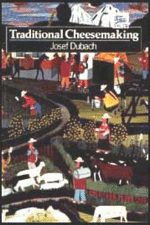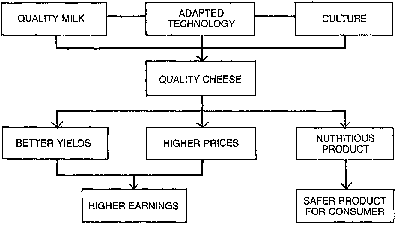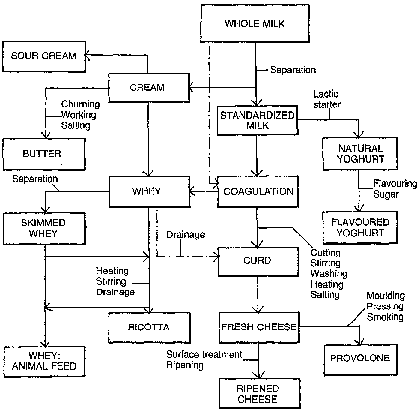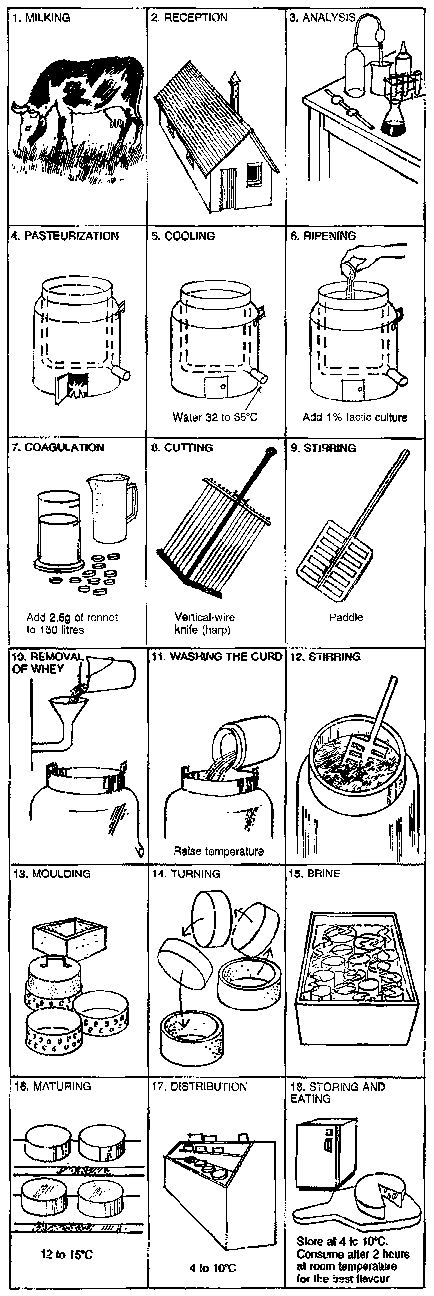Why make cheese?[edit | edit source]
There are many remote areas scattered throughout the world where dairy farming is a well-established occupation. Large quantities of highgrade milk can be produced in such areas but the local market cannot always absorb them, especially during peak periods. Converting milk to cheese is one method of dealing with the surplus. Cheesemaking provides an incentive for improving dairying as well as creating new jobs. It also improves the local diet and raises the standard of living generally, through a better understanding of hygiene, scientific techniques and community spirit. In a Third World setting, the local cheese plant often serves as a centre for community activities.
Nutritionally, cheese resembles meat but it is a more concentrated food. It contains large quantities of protein, fat and minerals and is rich in phosphorus and calcium which are both beneficial to growing children.
Figure 1. The 'knock-on' effects of cheesemaking
If rural cheese factories are organized as co-operatives or associations then the entire community will benefit. As members of a co-operative, dairy farmers who send their milk to the plant will have a stake in its development and future success. With a higher income, farmers can improve their herds, pastures, and dairy practices, and high quality cheese and butter will contribute towards a healthier national diet. But whatever structure the rural cheese factory adopts whether as a co-operative or as a private concern there is a 'knock on' effect which will be to everyone's advantage (see Figure 1).
Hygiene in both the cheese factory and the milking parlour is clearly vital. Cheesemakers must be trained to make products of the highest quality, so as never to put the consumer's health at risk. They must be able to solve the many problems which may arise during processing, and personnel must be trained to work conscientiously in constructing, equipping, organizing and administering the enterprise.
Location[edit | edit source]
There are several factors to be considered before deciding on the best location for a cheese factory. Due to production costs, cheese protein is more expensive than meat protein. It is advisable, therefore, to locate cheese factories in remote areas where milk distribution costs are high and demands are low. Siting cheese factories in heavily populated urban areas is less important, as fresh milk can be transported easily and cheaply and is always in demand, especially by children for whom it is a better source of nutrition than cheese.
In remote areas, cheesemaking can be the best way to overcome the problem of milk overproduction. By converting milk into cheese during periods of peak production, its nutritional value can be conserved and stored until needed, although it should be remembered that cheese cannot be kept forever, under normal circumstances. Economically, rural rather than urban locations are more suitable for cheese factories.
Traditional cheesemaking has a definite role to play throughout the world. In the Third World, many rural cheese factories are already in full operation and are producing a whole range of high-quality products. The fine cheeses of Europe are the result of hundreds of years of labour and research. Good cheesemakers must be willing to experiment and innovate to achieve the best results. Although cheese is usually made from cows' milk, every kind of milk can be employed. Excellent cheeses are made from goats' and ewes' milk. In Asia, yak and buffalo milk are used. Cheesemakers will often strive to imitate a well-known European cheese such as Gouda or Gheddar, but local conditions and national preferences will soon exert their influences and new types of cheese will emerge to suit local preferences.
International cheeses and cheesemaking[edit | edit source]
In the Himalayan area of Central Asia cheese is made from skimmed milk curds which are first acidified then stretched into thin strips by hand and left to dry on the roof until sufficiently hard. This type of cheese lasts for months and provides a reserve of food in winter.
In the Near East, the Bedouins make cheese from whole milk heated to approximately 80 C, then acidified with lemon juice to coagulate it. The whey is drained off and the curd pressed in straw baskets. When stored in brine, this type of cheese keeps for many months and will not be damaged by the desert heat.
France produces many soft variety names, the most famous of which are Camembert and Brie. Switzerland and Germany have produced Emmental and Gruyere for several hundred years, often in cooperatives. Renowned for their great size, they can weigh up to 110 kg. They have a hard consistency and an elastic texture with typical eyes of 1 to 2 cm diameter. Cheese is one of Switzerland's principal exports.
The UK, Australia, New Zealand, Canada and the United States all make cheese in large dairies, of which cheddar is the best-known variety. Holland produces Edam and Gouda and Denmark's main cheese is Danbo. Italy is famous for Parmesan, a cheese which requires prolonged storage for full maturation to produce its characteristic flavour.
A word of warning[edit | edit source]
For those deciding to establish a rural cheese production facility, patience and perseverance must be the key factors. Good hygiene both on a personal level and in the work environment is essential. Flexibility and good working relationships are desirable if top-quality products are to be obtained. Cheeses which are suspect or of inferior quality must not be released for sale to the public. These downgraded products can often be sold to large cheese factories for processing. Cheesemaking requires a balance of skill and technology, theory and good business practice which all combine to create top-quality speciality products that are highly desirable to the consumer.
The cheesemaking process described later in this book has been developed without the use of preservatives neither in the milk nor in the cheese. For this reason, cheese produced in this way will have a shorter shelf-life than other cheeses containing preservatives.
Basic cheesemaking principles[edit | edit source]
Cheese is milk curd a substance formed from the coagulation of milk by rennet and acid separated from the whey and pressed or moulded into a solid mass. It contains concentrated milk solids, water, rennet (to coagulate the milk), bacterial cultures (to acidify the milk and curds and produce desirable characteristics), salt, and, sometimes, calcium chloride. The calcium chloride is necessary in order to compensate for the loss of the free calcium in the milk resulting from the pasteurization process.
Cheesemaking equipment and methods vary but the basic principles have remained unchanged for thousands of years:
- Milking
2. Coagulation
3. Separation of curds and whey
4. Forming the curd into a cheese mould
5. Salting for conservation and flavour
6. Maturation and conservation.
Figure 2. Flow chart of the transformation of milk into cheese and its by-products
Traditionally salt was used in cheesemaking in order to preserve the product for a longer period. However, today conservation can be achieved by the use of lactic cultures, so that over-salting is no longer necessary.
The stages involved in the modern preparation of cheese are illustrated in Figure 3.
Figure 3. The cheesemaking process
The various stages of cheesemaking are described in detail in Part II of this book. Part I covers aspects of hygiene and basic microbiology, an elementary knowledge of which is required in order to appreciate the biochemical processes involved during processing. Part III deals with other products that may be produced from milk, and includes a section describing the construction of and equipment requirements for the preparation of cheese.



